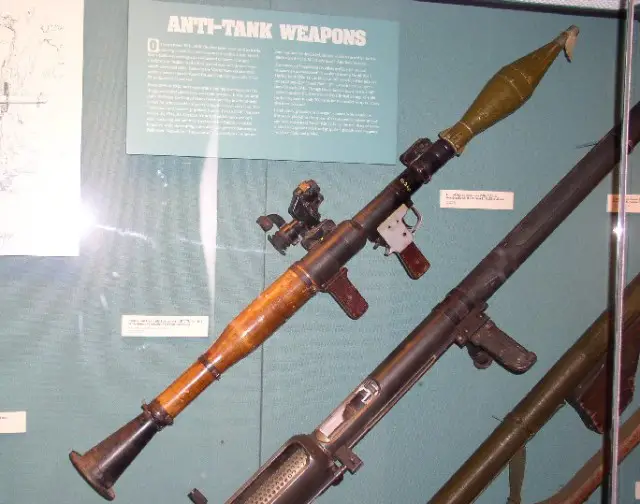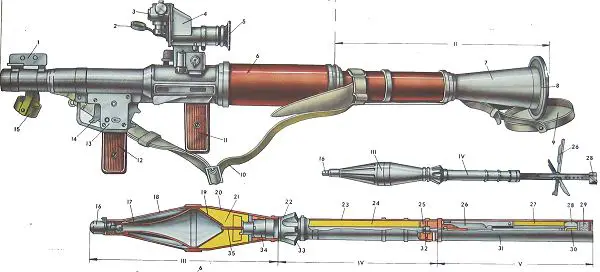|
| |
|
|
| |
| Description |
|
The RPG-7 is a Russian-made anti-tank grenade launcher. When the development of the RPG-2’s replacement began in May 1958, the GSKB-47 Design Bureau’s goal was to improve the RPG-2 concept and produce a weapon with increased range, greater accuracy, and a more lethal warhead. The RPG-7V is a remarkably simple weapon; its most complex components are its ammunition and optical sight. Simplicity means low cost, rapid production, ease of maintenance in the field, ease of training and operation, and, most importantly, high reliability and lethality. The RPG-7 is designed to defeat tanks, infantry combat vehicles, armored personnel carriers, self-propelled gun mounts, and other armored assets of the enemy. Initially thought of as an anti-armor weapon, it latter has been adopted for other fire-support missions by the introduction of various types of grenades, such as anti-infantry HE-FRAG, multi-purpose Thermobaric / FAE, and some other types of ammunition.
|
| |
|
Variants :
|
|
- RPG-7V: introduced in 2007 and was designed to accept night vision sights.
- RPG-7V1: equipped with a detachable folding bipod
- RPG-7V2: the latest version of RPG, capable of firing standard and dual HEAT, fragmentation and thermobaric rockets.
- RPG-7W: East German version
- RPG-7D: airborne troops, could be broken down into two sections.
- RPG-7D1: accept night vision sights
- RPG-7D2: the latest version of RPG-7D, capable to firing standard and dual HEAT, fragmentation and thermobaric rockets.
|
|
| |
|
|
| |
| Back to top |
| Design |
|
The RPG-7 has a large expansion chamber in its 40mm barrel, and approximately the rear half of the barrel is covered by a wooden sheath extending from the rear grip to the cone-shaped blast deflector. Newer models have phenolic-impregnated5 laminated wooden shields and the Chinese use phenolic shields. A trigger trip is mounted in the middle of the launcher tube.
|
| Rocket |
|
A wide variety of ammunition is available for the RPG-7 and is made in a number of countries. The antitank grenades for RPG-7 also came a long way, from the original PG-7V grenade, with penetration of about 260mm/10inches of RHA, and up to 500mm/20inches of RHA or 1.5 meters/5ft of brick wall with single-warhead PG-7VL grenade, developed in 1977. The antitank grenades are of combination type, using a charge of smokeless powder for RCL-type launch. Once the grenade reaches a safe distance from the shooter (about 10-20 meters), the built-in rocket booster engine ignites and further accelerates the grenade, greatly enhancing the effective range (up to 500+ meters for single warhead grenades, up to 200+ meters for much heavier tandem or FAE grenades). Each AT grenade consists of a large-caliber HEAT warhead with base fuze, with the 40mm diameter rocket engine behind. The rocket nozzles are located at the front of the engine, close to the warhead. The tail of the rocket is fitted with folding stabilization fins, which are extended when the grenade leaves the barrel. The original PG-7 projectile was 85mm, with a length of 899mm, and had flutes stamped in the nosecone. In 1969 the designer V. I. Medvedev developed a new HEAT projectile, the PG-7M. It was 70mm in caliber and 52mm longer than the original.
|
|
|
|
Other new rounds were the improved 72mm PG-7S, which entered service in 1972, and the 93mm PG-7L, with much-improved armor penetration, which was introduced in 1977. It could penetrate 600mm of armor, 1.1m of reinforced concrete, 1.5m of brick, and 2.5m of logs and earth. The 105mm PG-7R tandem warhead HEAT round was adopted in 1988 in an effort to defeat explosive reactive armor (ERA). It is expensive and to date, few have appeared on battlefields. The idea of the tandem warhead is that it has a small shaped charge on the end of an extender ahead of the main shaped charge. The small charge will cut a small hole into the armor, though not penetrating. The main charge will follow through the “starter-hole.” With ERA the small charge will detonate ERA bricks and should allow the main charge to penetrate undisturbed by the bricks’ detonation. Likewise, it will cut a hole through chain-link, slat-armor, or appliqué armor, allowing the main charge to hit the main armor. The PG-7R can penetrate 600mm of armor, 1.5m of reinforced concrete and masonry, and 2.7m of earth and logs. The impact of the PG-7LT round is similar but has slightly greater penetration.
|
|
|
| Sight |
|
The RPG-7 uses the PGO-7 optical sight, which is attached to the left side of the launcher between the two handgrips. The sight weighs 0.5kg and is a 2.7× reflex sight with a 13-degree field of vision. Yellow and green lens filters are provided to adapt it to different lighting and haze conditions. The sight reticle has three separate stadia and line sets: range estimation stadia at 100m intervals (200–1,000m) set for a 2.7m high target (the average height of a tank falls between Soviet tanks at 2.3m and US tanks at 3m), range lines at 100m intervals (200–500m), and lead and crosswind correction lines at 10-mil intervals (1–5), plus a bore sighting mark (+).6 A small battery-powered lamp can be attached to the sight to illuminate the sight reticle at night.
|
| Operations |
|
The RPG-7 is a shoulder-fired, single-shot, smoothbore recoilless launcher. Grenades are loaded from the front, and the rear of the barrel is fitted with a venturi nozzle. Because of the recoilless design, there is a dangerous backblast zone, more than 20 meters/60ft long. When fired the launcher cartridge propels the projectile out of the barrel at 117m/s. At 11m from the muzzle, the delay element ignites the rocket charge contained in the tail boom, boosting the velocity to 294m/s. The propellant charge is a hollow cylinder. The propellant burns forward and vents through six wedge-shaped lugs at the forward end of the tail boom just below the base of the warhead. These vents are angled 18 degrees outward, and being near the projectile’s center of gravity help stabilize it and create a torque opposite of the rotation imparted by the fins to reduce spin rate.
|
| |
| Specifications |
|
|
| |
|
Rocket
|
|
PG-7V, PG-7VL, PG-7VR, TBG-7V, OG-7V
a
|
|
Rocket weight
|
|
4.5 / 2.6 kg
|
|
Combat weight
|
|
6,3 kg ready to fire
|
|
Target engagement
|
|
200 to 500 m
|
|
Crew
|
|
1 soldier
|
|
|
Type of engaged targets
|
|
Light vehicle, infantry combat vehicle, armored personnel carrier, helicopter, building
|
|
Armor penetration
|
|
200 to 760 mm
|
|
Caliber
|
|
40, 70, and 105 mm
|
|
Guidance system
|
|
Optical sight and night vision
|
|
Dimension
|
|
Length, 950 mm
|
|
|
| |
| Country users |
|
Afghanistan, Albania, Algeria, Angola, Armenia, Azerbaijan, Belarus, Benin, Botswana, Bulgaria, Cambodia, Cape Verde, Chad, Congo, Croatia, Cuba, Czech Republic, RDC, Djibouti, Egypt, Georgia, Ghana, Guinea, Guyana, Iran, Iraq, Jordan, Kazakhstan, Kyrgyzstan, Laos, Latvia, Lebanon, Libya, Lithuania, Macedonia, Madagascar, Malta, Mauritania, Moldova, Mongolia, Morocco, Nicaragua, Nigeria, North Korea, Pakistan, China, Poland, Romania, Russia, Rwanda, Senegal, Seychelles, Siera Leone, Somalia, South Africa, Sudan, Syria, Tajikistan, Togo, Turkey, Turkmenistan, Ukraine, Uzbekistan, Vietnam, Yemen, Zambia, Zimbabwe.
|
| |
| |
| Details view |
| Back to top |
| |
|
|
| |
|
|
|
| |
|
|
|
|
|

































